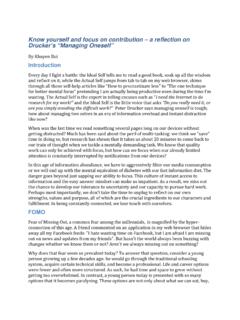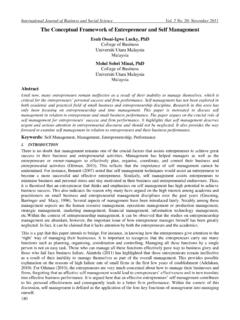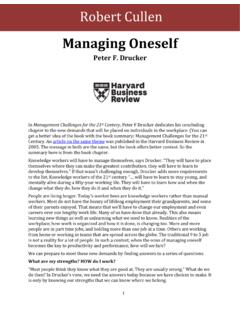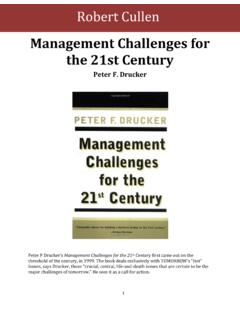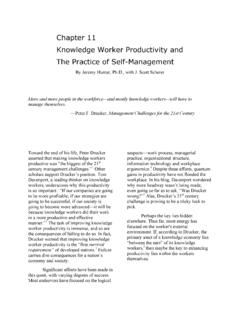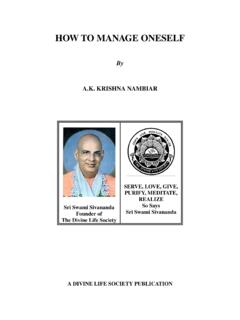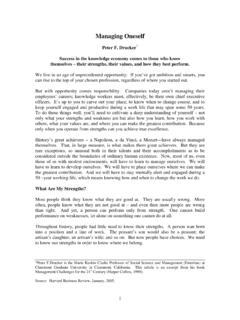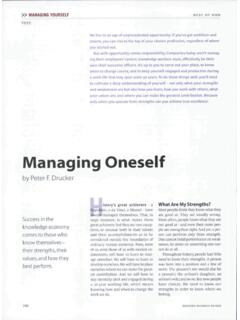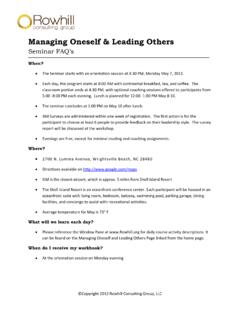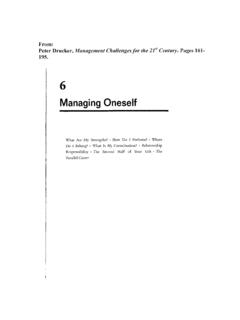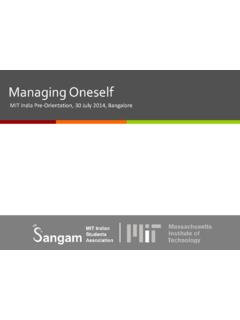Transcription of Managing, and Managing Oneself, in an Age of Information ...
1 Managing , and Managing oneself , in an Age of Information Inequality: Lessons from Peter Drucker Submission to the Global Peter Drucker Challenge 2015 Gregory Daniels | July 15, 2015 Digital technology is often conceived of as a great equalizer a significant means of 1economic development and reducing inequality. Many of today s leading companies are pursuing projects built on foundations of this premise. Google s Project Loon, for example, 2promises to bring Internet to the two thirds of the world population without access through a network of balloons in the stratosphere. The balloons will enable connection from phones and other LTE devices. Project Loon s introduction video, narrated by a young girl, communicates Google s economic goal in a final point: And because small businesses that are on the Internet grow twice as fast, everyone could create new opportunities for everyone.
2 3 Google likely derived this statistic from a report published in May 2011 by the McKinsey Global Institute titled Internet matters: The Net's sweeping impact on growth, jobs, and 1 As of this writing, a Google search for the term technology great equalizer turns up in the first five results articles and blog posts published by Business Insider, the White House, Living Cities, and the Association for Talent Development in which the ability of technology to level society is assumed. 2 Google s Project Loon, examined in this essay, and the Facebook led partnership are notable examples. 3 What is loon? , Google, accessed July 15, 2015, 1 prosperity . The authors of this report conducted an analysis of France s economy and found that over the 15 year period leading up to 2011 the Internet created million jobs and destroyed 500,000 others, creating a net 700,000 jobs or for every one destroyed.
3 The authors also 4surveyed 4,800 small and medium sized enterprises across 12 countries and found that, on 5average, the Internet created jobs for every one destroyed. McKinsey s conclusion: The 6 Internet is a powerful catalyst for job creation . While the firm s analysis shows that the Internet 7can drive economic growth, McKinsey s statistics do not begin to tell the story of who is gaining and who is not. The Digital Age, driven by the Internet as a disrupter or disorganizer , a term 8foresightedly coined by Peter Drucker almost 50 years ago, has made Information more accessible than it has ever been before. Access, however, does not mean equal economic gain, let alone a normal distribution of gain. Those with more gain more.
4 Those with less gain less, and sometimes not at all. Jane Margolis, a senior researcher at the University of California, Los Angeles and author of the pivotal book Stuck in the Shallow End: Education, Race, and Computing , calls this disparity virtual segregation . Margolis goes on to define virtual 9segregation as an insidious phenomenon that occurs when we are led to believe that we are moving toward equality, and pretend that everyone has a chance and a choice . Jon Gosier, a 10 TED Fellow and technology investor, more humorously calls this phenomenon trickle down techonomics . 11 4 Matthieu P lissi du Rausas, James Manyika, Eric Hazan, Jacques Bughin, Michael Chui, and R mi Said, Internet matters: The Net's sweeping impact on growth, jobs, and prosperity , McKinsey Global Institute, May 2011, 3.
5 5 McKinsey defined small and medium sized enterprises as those with less than 250 employees and annual revenue of less than 250 million. The 12 countries were Canada, China, France, Germany, India, Italy, Japan, Russia, South Korea, Sweden, the United Kingdom, and the United States. 6 P lissi du Rausas, Manyika, Hazan, Bughin, Chui, and Said, Internet Matters , 3. 7 Ibid. 8 Peter F. Drucker, The Effective Executive: The Definitive Guide to Getting the Right Things Done (New York: HarperCollins, 1967), 117. 9 Jane Margolis, Stuck in the Shallow End: Education, Race, and Computing (Cambridge: MIT Press, 2008), 2. 10 Ibid. 11 Jon Gosier, The problem with trickle down techonomics , TEDG lobal, October 2014, 2 Gosier continues: We tend to think that if we design things for the select few, eventually those technologies will reach everyone.
6 And that s not always the case. Technology and innovation behave a lot like wealth capital. They tend to consolidate in the hands of the few. And sometimes they find their way out into the hands of the many. 12 Information inequality is the greatest challenge to Managing , and Managing oneself , in the Digital Age . Knowledge workers, whether they manage people, projects, processes, and/or budgets, must possess a fundamental understanding of the digitally driven economy in order to empower themselves, their colleagues, their direct reports, and, ultimately, their business or organization. * * * I first encountered Peter Drucker s works as an undergraduate student at Pace University in New York. In my final year at Pace, I taught front end web development at the university s walk in tutoring center and my methodology, and the perspective I shared with students, was rooted in Drucker's approach to entrepreneurship.
7 It was also at this tutoring center that I first witnessed the digital divide Information inequality. I have been interested in technology since I was a child. I remember asking the librarian at my elementary school for books on the "green stuff in machines, like VCRs" and spending hours looking at pictures of electronic circuits. I was fascinated by their form and eager to know their function. There was no mission driving my interest in technology. I was simply curious. I took (and continue to take) great joy in finding the limitations of a tool, my limitations as a wielder, and then pushing both. I first had regular access to a computer at 10 years old, a secondhand IBM desktop running Windows A year later, my family bought an HP desktop 12 Ibid.
8 3 boasting an Intel Pentium processor, Windows 95, and an internal dial up modem. A trip to the local bookstore and an AOL installation disc later, I was online. The Internet became a place of fascination for me, a place to explore all sorts of obscure interests, and a creative medium. I taught myself to write markup and to script. I played. I broke things (mostly my own things). And I assumed that most people had experiences with technology similar to my own. The tutoring center quickly taught me otherwise. I had the privilege to teach a wide range of students with an even wider range of questions. The first half of the students who visited the center needed concepts explained in a way that was comprehensible to them, the opportunity to practice coding, and live feedback.
9 A few students who visited had dabbled in markup, wanted to solidify their understanding, and dig deeper into front end development. The second half of the students who visited the center had trouble with fundamental computing navigating an operating system and using word processing software. A few were essentially computer illiterate. This was both puzzling and distressing to me. I was the same age as the large majority of my tutees. Were we not Millenials? Were we not digital natives ? 13My learning of front end programming languages was driven by an intrinsic interest. Thus, when I would try to create a website, I never gave much thought to the many times that my layout would not display properly and the many more times that my script would not work.
10 Without knowing it, I was applying Peter Drucker s conception of entrepreneurship to my learning. In the original, 1984 preface to Innovation and Entrepreneurship , Drucker wrote: Entrepreneurship is neither a science nor an art. It is a practice. When I first read these two 14brief sentences at 21 years old, I interpreted them in the context of the etymology of the word entrepreneur . If one considers the French root entrepren or verb entreprendre (to undertake), then an entrepreneur is directly one who undertakes (something) . A student who systematically undertakes the learning of front end development (or any other subject for that matter), and in the process creates a new or different understanding within themselves, is an entrepreneur or, to invent a term, autoentrepreneur.
